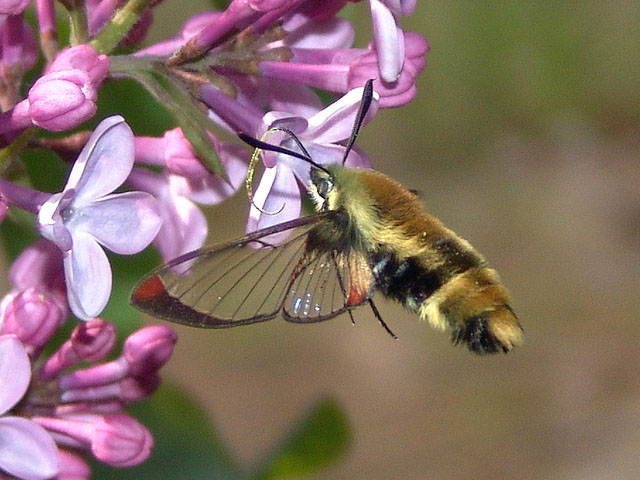
Hemaris diffinis (now aethra, Peterborough, Ontario, May 22, 2007,
courtesy of Tim Dyson.
courtesy of Tim Dyson.

This site has been created by Bill Oehlke.
Comments, suggestions and/or additional information are welcomed by Bill.
TAXONOMY:
Family: Sphingidae, Latreille, 1802 |
Subsequently thetis was synonymized with diffinis, but, based on paper by Christian Schmidt
Journal of the Lepidopterists' Society 63(2), 2009, 100-109. Hemaris thetis (Boisduval, 1855) (Sphingidae), H. thetis in
now recognized as a distinct species, based on DNA and genitalia analysis.
In some places just East of the Divide (Colorado, Alberta) overlap of ranges of H. thetis and H. diffinis is known and precise
determinations, by photographs only, will be next to impossible.
Thanks to Edna Bottorff and Ryan St. Laurent for alerting me of this change. It will be a little while before I get the changes made on the Sphingidae of the
Americas website.
I will shortly create the H. thetis page and will move all appropriate images off this page and add them to the new page.Those Sphingidae west of the continental divide, previously thought to be H. diffinis are now determined to be
the recently elevated species, Hemaris thetis. It is my understanding that the moths described as H. senta also belong to
H. thetis as thetis was described (Boisduval, 1855) before senta was described [Strecker, 1878].
Generally H. ethra has a more northerly range than does diffinis, and ethra has been recorded in Manitoba, Ontario, Quebec, New Brunswick and Nova Scotia and
in northern adjacent states: probably northern Wisconsin, Michigan, New York, Vermont and Maine. Two reports from Oklahoma and Arkansas need more careful scrutiny.
The two species are known to be sympatric in eastern Ontario and are probably also sympatric in some other regions.
On average H. aethra, when compared to H. diffinis, tends to be slightly larger, with a more orangey-yellow tone, slightly larger reddish brown apical
area (more than 50% of apical area) and less tapering (top to bottom) of the dark thorax/abdominal region.Derek Bridgehouse recently alerted me to the reinstatement of Hemaris aethra (Strecker, 1875) as a valid species. For close to 100 years
aethra has been in synonymity with Hemaris diffinis, and the two species are very difficult to distinguish and, in some areas, they are sympatric.
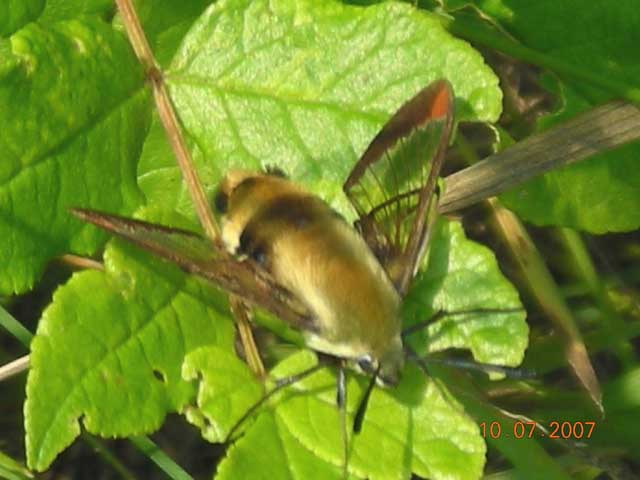
I have seen neither diffinis nor aethra on Prince Edward Island, Canada.
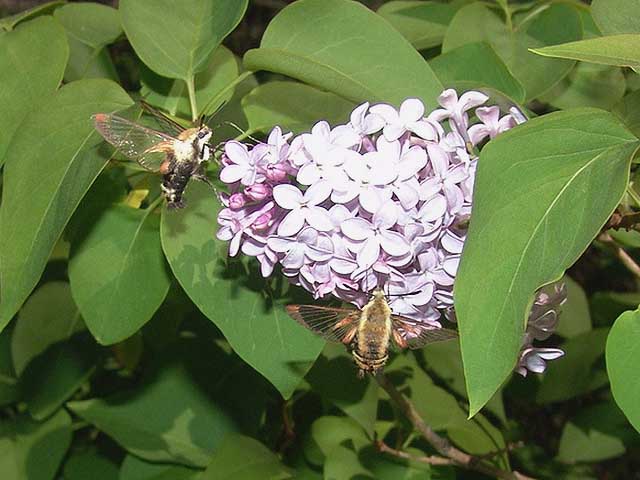
Adults mimic bumblebees and are quite variable, both geographically and seasonally. The wings are basically clear, with dark brown to brownish-orange veins, bases and edges. The thorax is golden-brown to dark greenish-brown. The abdomen tends to be dark (black) with 1-2 yellow segments just before the terminal end. These yellow segments are in much sharper contrast to the rest of the abdomen than in somewhat similar species. Also note the relatively narrow dark outer margin of the hindwing. Most fresh specimens also have some blue "fur" tufts highlighting the first black band on the abdomen. The dorsal surfaces of the legs in Hemaris thysbe are whitish-pale grey, and the legs of Hemaris gracilis are red. Note the very black legs of Hemaris diffinis.
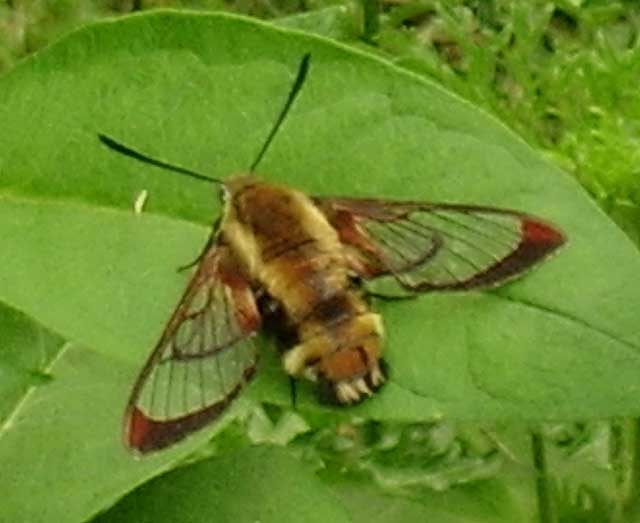
Hemaris aethra, Val des Monts Quebec, June, 2012; J. N.
Larvae pupate in thin walled cocoons under leaf litter.
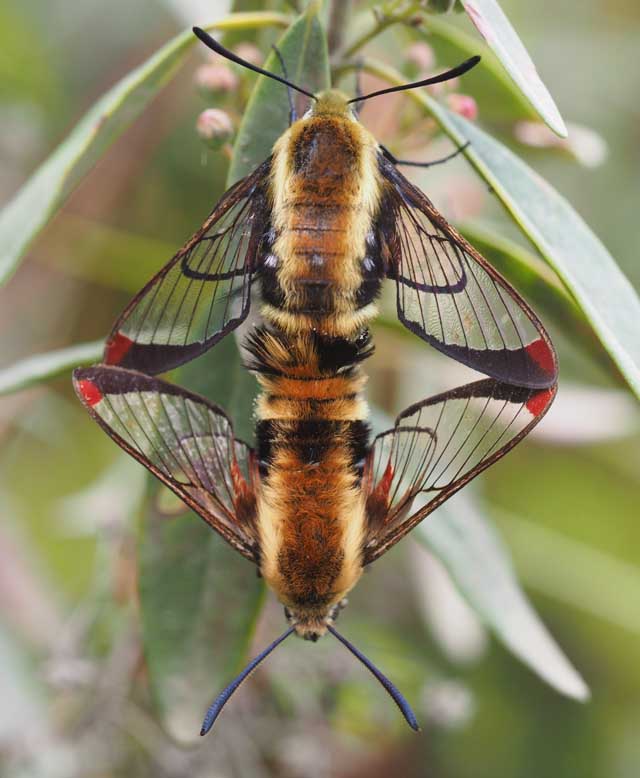
Hemaris aethra in copula, Hammonds Plains, Nova Scotia,
June 21, 2018, courtesy of Krista Melville
There is also a brown form. Ian Miller writes, May 20, 2009, "All 30 of my first snowberry clearwings are in their 3rd instar and are all brown! I don't know if first generations are usually all brown or if it has something to do with being inside, but I find it to be unusual because usually it's 50-50," i.e., usually half are green, half are brown.
Larval host plants include Snowberry (Symphoricarpos), honeysuckle (Lonicera), Coralberry, viburnums, Blue Dogbane (Apocynum) and dwarf bush honeysuckle (Diervilla lonicera).
Larval image to the right courtey of Tony Thomas.
Pupation is in a very flimsy cocoon at ground surface. The inch long pupa is brown.< Visit Hemaris diffinis prepupal larva, Eau Claire County, Wisconsin, August 28, 2008, Ian Miller.
Visit Hemaris diffinis prepupal larva, near Gull Lake, Alberta, August 14, 2011, Robert Bercha.
Larvae can vary, but in most cases the final instar has a long black anal horn, lighter or yellow near the base. Spiracular circles tend to be very large, prominent and black, but there are regional differences. Western types often have a shorter, thicker horn and much smaller and lighter spiracular circles.
Green colouration of larvae is typical, but just before pupation larvae often darken to purplish-brown.
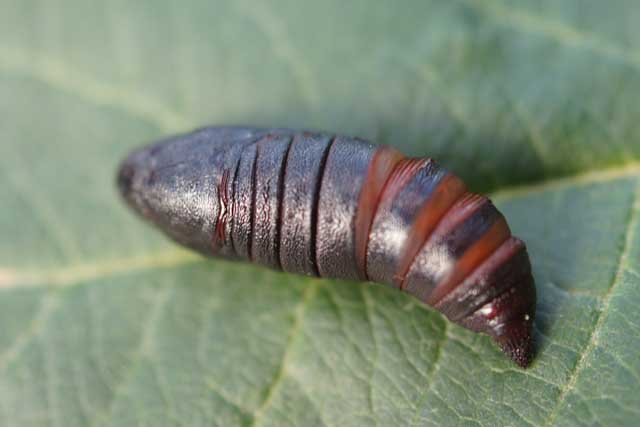
Hemaris diffinis pupa (dorsal), Saskatchewan, Canada,
courtesy of Tim Taylor
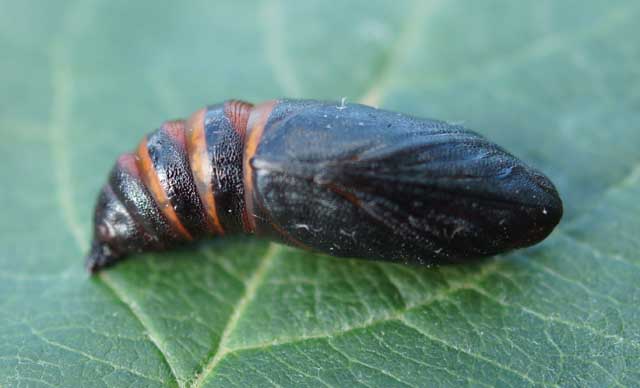
Hemaris diffinis pupa (ventral), Saskatchewan, Canada,
courtesy of Tim Taylor
Those who first published descriptions and assigned scientific names to many insects, simply chose names of
biblical or mythological origin without any real descriptive qualities. Their purpose was simply to set a standard for purposes
of identification by assigned name. On some occasions, names, mostly of Latin or Greek origin, were chosen to signify a particular
character of the genus or of an individual species.
The genus name "Hemaris" is probably a Latin adjective form for blood. It may have been chosen by Dalman based on the burgundy-red
scales on the wings.
The original choice of "Macroglossa" would have been for the relatively large, glassy (clear) areas of the wings.
The species name "aethra" probably comes from Greek mythology. Take your pick.
The suggested pronunciations, on this page and on other pages, are primarily put forward to assist those who hear with internal ears as they read.
There are many collectors from different countries whose intonations and accents would be different.
Aethra which means the "bright sky" was a name applied to four different individuals (Wikipedia):
"Aethra, name of one of the Oceanids, the 3000 daughters of Oceanus and Tethys. She is sometimes called the wife of Atlas and mother of the Pleiades, Hyades
(more usually the offspring of Pleione) and Hyas.
Aethra (possibly same as above) is, in one source, called the wife of Hyperion, rather than Theia, and mother of Helios, Eos, and Selene.
Aethra, daughter of King Pittheus of Troezen and mother of Theseus either by Poseidon or Aegeus.[6][7] This is the same Aethra who went to Troy with Helen as
one of her two handmaidens.
Aethra, wife of the Spartan Phalanthus. She fulfilled the prophecy given to her husband by her tears, after which he conquered Tarentum for himself."
Return to Sphingidae Index
Return to Dilophonotini Tribe
Return to Hemaris Genus
Enjoy some of nature's wonderments, giant silk moth cocoons. These cocoons are for sale winter and fall. Beautiful Saturniidae moths will emerge the following spring and summer. Read Actias luna rearing article. Additional online help available.
Use your browser "Back" button to return to the previous page.
This page is brought to you by Bill Oehlke and the WLSS. Pages are on space rented from Bizland. If you would like to become a "Patron of the Sphingidae Site", contact Bill.
Please send sightings/images to Bill. I will do my best to respond to requests for identification help.
 Show appreciation for this site by clicking on flashing butterfly to the left. The link will take you to a page with links to many insect sites. |